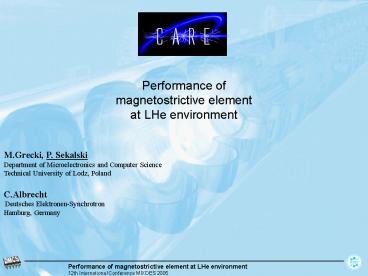Performance of magnetostrictive element at LHe environment - PowerPoint PPT Presentation
1 / 13
Title:
Performance of magnetostrictive element at LHe environment
Description:
PWM amplifier is under investigation. Performance of magnetostrictive element at LHe environment ... to the piezo one, including: ... – PowerPoint PPT presentation
Number of Views:134
Avg rating:3.0/5.0
Title: Performance of magnetostrictive element at LHe environment
1
Performance ofmagnetostrictive element at LHe
environment
M.Grecki, P. Sekalski Department of
Microelectronics and Computer Science Technical
University of Lodz, Poland C.Albrecht Deutsches
Elektronen-Synchrotron Hamburg, Germany
2
Outline
- Motivation of experiment,
- Magnetostrictive tuner specification,
- Experiment description,
- Plans for future,
3
Motivation for experiment
Magnetostriction of different materials in
function of temperature (courtesy of ENERGEN).
- Magnetostrictive elements
- might have a higher lifetime,
- are immune to shortcuts,
- generate less heat,
4
Magnetostrictive tuner specifications
61.8 mm
22 mm
50 mm
5
Magnetostrictive tuner prototype
Build by ENERGEN Inc.
Ferrite necessary to close magnetic circuit
Superconducting coil (Nb3Sn)
Plunger Belleville springs
Niobium Cover
Active magnetostrictive element with ferrite,
s.c. coil and thermal connectors
Magnetostrictive rod(made of Kelvin ALL)
Thermal connectors
6
Magnetostrictive tuner experiment
- Experiment goals
- Run tuner at low temperature,
- Transfer function from magnetostrictive element
to piezoelectric one - Transfer function from piezoelectric element to
magnetostrictive one - Characterize magnetostrictive tuner vs. NOLIAC
piezo stack (similar experiment with two
piezostacks was done) - - stroke vs applied current
- maximal frequency
- Heat dissipation (temperature rise)
7
Power Transconductance Amplifier
- Technical Specifications
- Maximum output current amplitude 8 A
- Maximum pulse duration 2.3 ms
- Maximum repetition frequency 20 Hz
- Amplification 3.33 A/V
PTA based on PA93 APEX Power Operational
Amplifier PWM amplifier is under investigation
Schematic of amplifier (designed by G. Jablonski,
DMCS-TUL)
8
Magnetostrictive tuner experiment
Measured data
Calibration data from INFN
The data obtained by Energen is done for
preload of 400N. (no measurement for preload was
performed at LHe temperature)
2µm of displacement for 8A
9
Magnetostrictive tuner - future test
- Two new magnetostrictive rods from EXTREMA are
ordered. They are made of GalFeNOL. - We would like to perform a characterization of
all 3 rods (or more if possible) similar to the
piezo one, including - Displacement measurement versus magnetic field
applied to device for different preload settings
(i.e. 0N, 1kN, 2kN, 3kN), - Max. stroke,
- Dynamics of motion,
- Heat generation coil is made of Nb3Sn,
- Magnetic field distribution (if possible)
10
Magnetostrictive tuner - future test
Displacement sensor
Membrane
Interface need to be designed
Flange for high current wires (up to 16 Amps)
Flange for temperature and magnetic field sensors
wires
Magnetostrictive rod inside superconducting coil
Temperature sensors (its positions are under
investigation )
Magnetic field sensors
Screw for preload force adjustment
11
Conclusions
The maximal displacement of magnetostrictive
tuner was less than 2um. The data might be not
exact, because the preload force and boundary
condition were not well controlled (It might
happen that the preload force was higher than
1kN, because stiffness of fixture was unknown at
low temperature). Small delay between input and
output signal might be observed (around 70us).
In principle it might be explained by the
magnetostrictive element hysteresis (as it is
observed in RT temperature). Finally, performed
experiment does not give the quantify results,
but the main goal of test was reached the tuner
was run successfully at LHe temperature. On the
other hand, the detailed magnetostrictive rod
characterization is strongly required. Using the
obtained experiences, the proper experiment will
be prepared and performed soon.
12
References
1 TESLA Technical Design Report, DESY
2001-011, 2001 2 T. Schilcher, Vector Sum
Control of Pulsed Accelerating Field in Lorentz
Force Detuned Superconducting Cavities, PhD
thesis 4 S.N. Simrock, Lorentz Force
Compensation of Pulsed SRF Cavities, Proceedings
of LINAC 2002, Gyeongju, Korea 5 M. Liepe,
W.D.-Moeller, S.N. Simrock, Dynamic Lorentz
Force Compensation with a Fast Piezoelectric
Tuner, Proceedings of the 2001 Particle
Accelerator Conference, Chicago 6 L. Lilje,
S. Simrock, D. Kostin, M. Fouaidy,
Characteristics of a fast Piezo-Tuning
Mechanism for Superconducting Cavities,
Proceedings of EPAC 2002, Paris, France. 7
P. Sekalski, S. Simrock, L. Lilje, C. Albrecht,
Lorentz Force Detuning Compensation System for
Accelerating Field Gradients up to 35 MV/m for
Superconducting XFEL and TESLA Nine-Cell
Cavities, MIXDES 2004, Poland 8
Magnetostrictive tuner datasheet, ENERGEN, INC
13
Thank you for your attention































